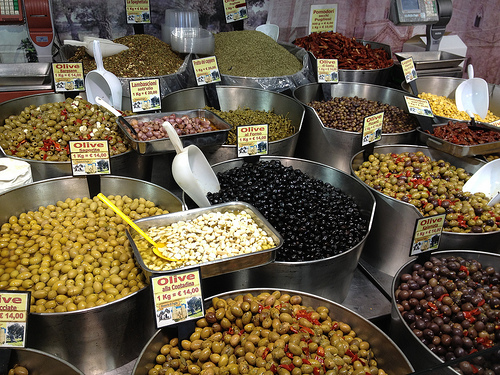
Until fairly recently, I thought that I hated olives. But a few months ago, I learned that I just hate black olives. Green olives are so much more firm in texture, and often come stuffed with yummy things like garlic spears. What is the difference between green and black olives, and what can you do with olives (aside from eating them straight from the jar with a fork)?
No one knows who first domesticated the olive. It has been grown as a crop in the Mediterranean for thousands of years, and is a symbol of fertility, prosperity, and peace.
For years as Americans we were mainly only familiar with the canned black olive (particularly as a pizza topping) but some of the huge variety of olive types and preparations are gradually creeping into our food culture. Heck, the Safeway in my rural part of Washington State even has an olive bar where you can buy fancy olives with various marinades out of plastic deli tubs by the pound.

Image courtesy Flickr/wollombi
Olives, nutritionally speaking
You have no doubt heard of all the health benefits of olive oil. Olives themselves provide all of those health benefits, plus an additional kick of fiber and the antioxidant vitamins A and E. There are no nutritional difference between black and green olives.
On the down side, olives can have a lot of sodium, since they have been pickled. Olives are high in fat, but it's the good kind of fat (monounsaturated fats) which have anti-inflammatory properties and help reduce the risk of colon cancer, rheumatoid arthritis, and asthma.
Black versus green olives
The difference between a black olive and a green olive is the level of ripeness before it was picked. A green olive is picked before it's ripe, whereas a black olive has been fully ripened. This makes green olives more dense and firm, and it means that black olives have a more strongly olive-y flavor.
It seems that green olives are usually stuffed with something. So far I have liked the garlic-stuffed kind, loved a double-stuffed variety that had garlic and jalapeno, loathed the pimento-stuffed kind, and been put off by a variety that was stuffed with almond spears (too crunchy).

Image courtesy Flickr/andrea.pacelli
What about Kalamata olives?
The Kalamata olive is named after the Greek town where they are grown. These legendary olives are unusually large, and have a texture described as "meaty." They are more delicate than regular olives, and must be hand-picked only after they are ripened on the tree.
Unlike California black olives, Kalamata olives are not artificially ripened with a lye treatment. They are usually just pickled, the same way as green olives. This helps preserve their texture and flavor. Some Kalamata olives are soaked for several months in salt water in order to remove some of the bitter flavor.
How olives are made
Raw olives are so hard and bitter that they are basically inedible.
Green olives are cured in a strong brine solution for eight months, then packed in a brine solution and shipped out. This is what makes green olives so salty, compared to black olives. (Tip: Rinse your olives in cool water and drain before serving. It helps mitigate the salty flavor.)
By comparison, most black olives (in particular, those labeled "California black olives") are artificially ripened. They are given a lye treatment which both softens the flesh and turns them darker. They are then put in a light brine solution, and are cooked as part of the canning process (which also changes the flavor and makes the flesh more tender).

Image courtesy Flickr/Gerry.Hawkins
Using olives
If you feel weird about eating olives straight from the jar, you can always dispense them into a small dish and eat them out of that. Okay, I'm just kidding, there are some other things you can do with olives.
(But just eating them plain seems to be one of the most common options. These are called "table olives.")
Tapenade is a popular option for olives. It is a savory, flavorful spread that is a big hit on an appetizer or snack tray. All you need is a food processor and a few ingredients: olives, anchovies, garlic, capers, basil, maybe a squeeze of lemon juice. Blend it all together into a coarse paste, and use as a topping for crackers or crostini, as a sandwich filling, and more.
Main image courtesy Flickr/Bunches and Bits (Karina)

5 comments